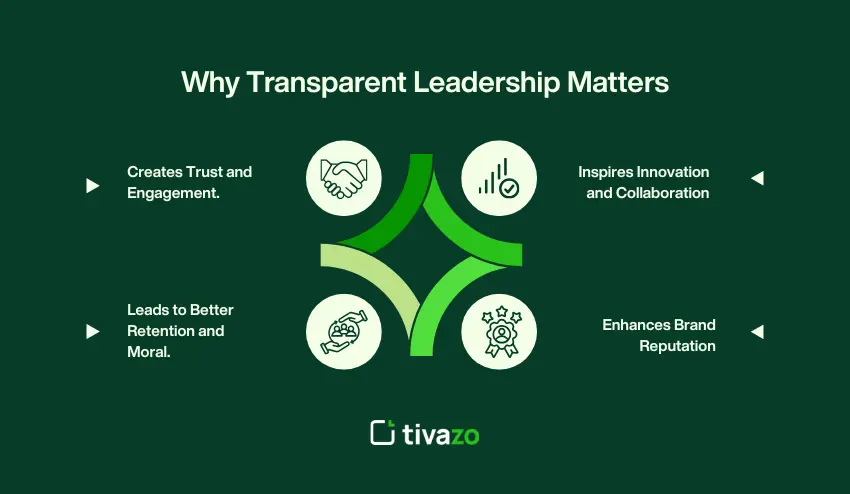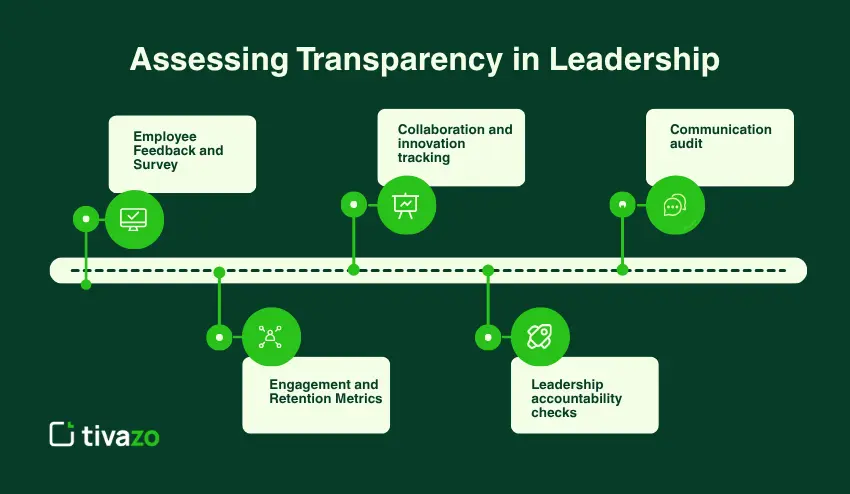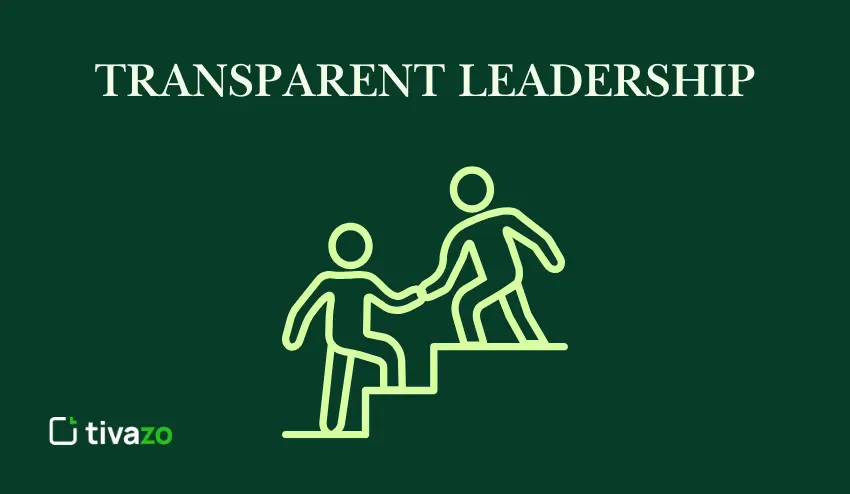Today’s fast-paced business environment is characterized by employees desiring more than just orders from their leaders. They want honesty, authenticity, and clarity. Transparent leadership has become a definitive characteristic of high-performing organizations for this reason. Naturally, people are drawn to leaders who communicate openly, who willingly disclose their failures and provide context for decisions rather than hiding problems behind corporate speak.
However, although there is a need for transparent leadership, it seems to be overlooked. An American Psychological Association survey informs us that only about fifty percent of employees believe their managers truly exhibit being an open book. That lack of clarity leads to distrust, disengagement, and ultimately turnover.
On the bright side, transparent leadership is a skill and, therefore, can be developed. In this article, we will discuss what it means to lead transparently, why it matters in today’s workplaces, and how leaders may execute well-established strategies to create trust, cooperation, and performance in their teams. By the end of the article, you will have a clear pathway for leading with transparency as a key leadership behavior in 2025 and beyond.
What Is Transparent Leadership, Really?

Transparency in leadership is often misunderstood. Some believe it means oversharing every detail of the company. When we talk about transparent leadership, it is usually misconstrued. Some people think of it as sharing every detail of the business untethered by ethical constructs or turning the workplace into confessionals. The truth is, transparent leadership means being honest, accountable, and communicating clearly. It means you are committed to keeping the team informed while cultivating trust and respect amongst you.
True transparent leadership is the creative and responsive nature of being open and accessible to work with. Leaders with clear transparency in their leadership,
- Communicates openly, even when they do not want to
- Will own your mistakes and be an example to you on how I learned from the mistake
- Make the decision visible to the team and explain why it was made, so you can see the “why”
This helps employees not be guess what the company is working on or why they would make a critical decision. It creates a culture where we can learn from our mistakes, rather than hiding failures.
Transparency, Vulnerability and Authenticity
While related, these three aspects are not the same.
- Transparency is the quality of sharing information and context openly.
- Vulnerability is when you admit to not having all the answers or when something challenges you personally.
- Authenticity is staying true to one’s values and self as a leader.
A leader who possesses all three fosters a climate of trust, engagement and collaboration. Transparent leadership is the observable demonstration of authenticity and vulnerability in practice.
The Psychological Principle Behind Transparency in Leadership
To grasp the importance of transparent leadership, it is worth considering human behavior and what being on a team means. Transparency is not a workshop word used by manager types; it exists in the field of psychology, as it is undeniably correlated to trust, engagement, and performance.
Transparency Promotes Psychological Safety
Employees are at their best when they feel safe to share ideas, ask questions, and admit they have made a mistake without being judged or punished. When leaders are transparent, it encourages an environment to feel safe where be honest, share struggles, clear performance expectations, explain how a decision was made, and be transparent about mistakes or challenges.
Employees feeling psychologically safe is a precursor to contributing ideas, trusting people to take risks, and trusting people will work with you. An example of a psychologically safe environment shows up in Google’s Project Aristotle, which demonstrated that psychological safety is one of the most significant predictors of team efficacy.
The Neuroscience of Trust
Additionally, transparency as a principle is rooted in trust, which is a neurological trust pathway. When leaders are authentic and transparent, oxytocin is increased in those being led, creating the desire for cooperation and strong social bonds. If leaders are lacking in transparency, it adds to uncertainty and stress, which increases defensiveness that slows creativity and collaborative actions.
Why Followers Trust Leaders Who Excercise Transparent Leadership
Workers are drawn to leaders who are open and consistent. When leaders recognize failures and openly celebrate successes, employees experience fairness and value. This allegiance leads to engagement and commitment, lasting well beyond the entry period of work. Transparency also limits ambiguity and diminishes anxiety, which is often caused by speculation or rumors, allowing workers to focus on measurable results instead of hidden agendas.
Foundational Pillars of Transparent Leadership
The practice of transparent leadership occurs most effectively when there is a definitive set of principles that structure behavior and decisions. In order to make this more practical, we share the 4C Model of Transparent Leadership, as it can bring less philosophy and more implementation for individual leaders.
1. Clarity
The bedrock of transparency is communicating in precise detail on goals, expectations, and decisions. Leaders need to clearly articulate to the team the rationale of why we’re doing work, what their role is, and how we will consider these objectives successful. Without clarity, transparent communication, even from an authentically honest place, can lead to confusion and uncertainty.
Example: A team leader goes over the quarterly objectives, also sharing the rationale of why certain projects were prioritized and some weren’t, so the team understands the ‘why’ behind the decisions and more than just the objectives.
2. Communication
A transparent atmosphere will need open, two-way communication. It is not simply a matter of announcing information. It has a component of active listening and encouraging feedback. Leaders will want and need to develop regular channels for the exchange of information, updates, and most importantly, for problem-solving.
Example: Weekly team meetings where employees can go directly to the leaders to ask questions about the company’s performance or a strategic decision that would be respected without fear and with trust would reach Engagement and Trust.
3. Consistency
Being consistent with your words, actions, and values builds credibility. When leaders claim to follow a course of action and then display a different set of behaviors, it will cost them trust. Transparent leaders constantly demonstrate behavior that correlates with their values and their policy.
For example, if a company says it cares about staff development, the leaders ought to provide opportunities for staff growth, conduct training, and provide staff mentorship on a consistent basis that connects to that value.
4. Courage
Transparent leadership requires courage; the courage to admit errors, disclose hard truths, and act on feedback. Courage demonstrates authenticity, and it highlights to the team that the leader is willing to support the health of the organization above their own ego or representation.
An example is if a CEO publicly admits to a mistake on a strategic rollout and shares what they learned, inspiring the team to embrace innovation and tackle problems without fear.
Why This Framework Works:
When the organization applies the 4Cs – Clarity, Communication, Consistency, and Courage, leaders will create a culture in which transparency is a norm and not an exception to the culture. The 4Cs framework helps ensure transparency is actionable, measurable, and sustainable in any organization.
Why Transparent Leadership Matters (and Its Business Impact)
Transparent leadership is more than just the “right thing to do”; it translates into metrics on team performance, employee engagement, and overall organizational effectiveness. Applying transparently encourages openness and honesty, building a culture of trust, innovation, flexibility, and sustainable growth.

Creates Trust and Engagement.
Transparency increases trust between leaders and employees. When team members see leaders being open about challenges, goals, or the decision-making process, they feel respected and valued. This holds true whenever trust builds, and with trust comes real engagement and collaboration, which allows for a potential shared purpose. Employees are naturally inclined to take initiative and go the extra mile when they understand the “big picture.”
Leads to Better Retention and Moral.
Employees want to work for leaders and organizations that they trust and believe in. A transparent culture mitigates uncertainty and anxiety (ask any follow in a rumor-driven workplace), and ultimately helps employees believe in their organization’s leadership. Organizations where transparency is valued tend to have lower turnover and higher morale (which can be quantified in dollars), saving you a significant amount of money in recruiting to replace turnover of top talent.
Inspires Innovation and Collaboration
When information is shared and communicated openly, teams are even better positioned to generate ideas and solve problems. Transparent leaders embrace open dialogue and feedback, cultivating an ecosystem of employee safety to experiment and contribute ideas. By nature, collaboration will invariably lead towards innovative solutions that would be impossible in a close mindset, hierarchy, or lack of trust.
Enhances Brand Reputation
Transparent leadership applies to external audiences, not just internal teams. Organizations known for being open, honest, and transparent attract customers, partners, and prospective employees who appreciate and regard integrity. Companies like Patagonia, Buffer, and GitLab have used transparency to help build strong reputations while fostering trust among constituents.
Examples of Transparent Leadership Practiced Effectively in the Real World
Observing what transparent leadership looks like in practice can provide important lessons for leaders of any level of experience. The following examples from highly visible leaders show how they are implementing transparent leadership to create trust, encourage engagement, and achieve organizational success.
Mathilde Collin — CEO, Front
Mathilde Collin leads her team with transparency about the company goals and how they are progressing by consistently sharing this information with the entire team. Weekly all-team meetings and regular communications about the accomplishments for the company objectives ensures that everyone is in alignment. She also provides public access to larger-scope goals for the company to “clarify and potentially unify” those goals. This process allows team members to take ownership of their “work” for the company.
Yvon Chouinard — Founder, Patagonia
Yvon Chouinard demonstrates transparent leadership through the manner in which he provides honest evaluations of the impact “on the environment” from the actual products of Patagonia through things like the Footprint Chronicles. This degree of transparency contributes to trust with customers, in addition to creating a sense of responsibility with employees to engage sustainability.
Satya Nadella—CEO, Microsoft
Rather than adhering to more traditional corporate values like accountability, ownership, results, and growth, Satya Nadella shifted Microsoft’s culture to encourage empathy, open discussion, and accountability. By embracing failure, talking about lessons learned, and letting employees share feedback with one another, Satya has ushered in a new work environment, opening the door to collaboration and innovation.
Claire Schmidt—CEO, AllVoices
Claire Schmidt has cultivated AllVoices into an inclusive environment that makes employees feel comfortable reporting an unsavory subject anonymously while progressively opening the floor for questions regarding topics at hand. Claire’s leadership style has led to a culture of trust and psychological safety that pushes AIIVoices to not shy away from having conversations regarding difficult topics.
Ed Catmull—Co-Founder, Pixar
Ed Catmull created Pixar’s “Braintrust” meetings to allow for open discussion on projects and receive candid feedback with no hierarchy. This opportunity for transparency and collaboration has enabled Pixar to produce consistently high-quality creative work through openly discussing what was learned in real time to be rapidly adapted and improved.
How to Cultivate Transparency in Leadership at Work Every Day
Implimenting transparent leadership can take time and practice. These strategies outline a process for leaders to develop a culture of openness, accountability, and trust.
Communicate Openly and Often
Regularly communicating with teams keeps everyone on the same page and reduces ambiguity in the workplace environment. For example, leaders should feel comfortable sharing progress reports on the company, its goals, and obstacles that arise or are anticipated, in a way that is relevant and understandable to all levels of staff. Using communication tools like team meetings, dashboards that all can share in, and newsletters can set a standard tone in consistent communication.
Create Two-Way Feedback Loops
Transparency in leadership style is more than disseminating information; it is also about listening. Invite employees to provide feedback, ask questions, and report any concerns. Using anonymous surveys, suggestion boxes, and skip-level meetings can give employees the comfort level to speak freely and feel valued and heard.
Be Honest About Mistakes
If you want to model accountability and value a learning-based culture where failure is embraced, you have to be honest about your mistakes. Your authentic description of where something went wrong with projects, what you learned from your mistakes, and how you will handle it differently will build trust, and illustrate the goal is not perfection, but growth.
Provide Context to Decisions, not just Decisions
Employees need to understand the “why”. Providing the context of why you made a strategic choice, prioritized something, or accept a tradeoff employees can understand where to focus their efforts, as well as reduce confusion by speculation.
Lead by Example
Transparency starts with leaders. Leaders who consistently model the behaviors of open communication, accountability, and integrity set the cultural tone of your organization. When employees see the leader modeling transparency, they are likely to carry out in their own work.
Addressing the Obstacles to Transparent Leadership
While transparent leadership has its merits, it does come with challenges. Smart leaders will recognize these barriers and intentionally work around them to maintain transparency while keeping their team within appropriate boundaries of confidentiality.
Transparency Vs. Confidentiality
Not all information can be divulged publicly. Things like employee personal information, sensitive financial information, or complex business strategy may have to be kept private, due to careful consideration. Transparent leaders respect transparency and confidentiality, knowing how to add context to why some information may not be shared while making every effort to communicate as honestly as possible.
Risk of Potential Backlash
Some leaders may be paralyzed by the hesitation or fear of backlash if they are too transparent or vulnerable to their team. The only way to overcome this barrier is with bravery and consistency. Through a sustained model of transparency to help assuage the risk of potential backlash, leaders can build trust in their leadership and reduce the likelihood of anxiety within their teams when discussing specific issues or topics.
Beware of Information Overload
On the other hand, providing too much information and detail can also create confusion or overwhelm employees with competing complex information. Victorious transparent leaders seek to relay relevant or contextual information that is actionable with data or facts, which ultimately helps employees to contextualize how to understand this information and improve their decisions in support of the best interests of the organization.
Assessing Transparency in Leadership
Transparent leadership is valuable when you can assess its effectiveness. After all, tracking transparency can help leaders evaluate how their efforts are affecting trust, engagement, and performance.

1. Employee Feedback and Survey
Regularly soliciting feedback by utilizing surveys, one-on-one interviews, or focus groups will help you understand how employees feel about overall transparency. Feedback can be used to assess employee feelings about the clarity of communication, how information is shared, and whether the leadership team is open to sharing ideas from the team.
For example, “Do you feel that you have been kept informed about decisions made by the company and the rationale for those decisions?” or “Does leadership discuss both successes and challenges openly?”
2. Engagement and Retention Metrics
Employee engagement and retention may be an indicator of transparent leadership if employee engagement is high and there are low levels of turnover. You can assess employee engagement through employee satisfaction scores, attrition rates, and employee participation in company-supported initiatives.
3. Collaboration and innovation tracking
Teams in transparent environments are more apt to collaborate and innovate. You may want to measure how many cross-team projects, ideas submitted, or process improvements that employees initiated. This identifies if employees are working openly and if they are proactive and creative.
4. Leadership accountability checks
Transparency also means holding leaders accountable. Review if leadership always shares updates, seeks feedback, and demonstrates transparency themselves. Self-assessments and/or peer reviews can help establish expectations of transparency.
5. Communication audit
Regularly audit communications for easy access, frequency, and clarity. Are all employees getting the updates? Is the information shared clearly and in a concise manner? This type of audit will help your organization realize gaps in communication and provide improvements to your organization’s transparency practices.
Conclusion
Transparent leadership surpasses a simple management model: it provides an opportunity to create trust and promote collaboration, and to reinforce and empower employees to do their best work. When leaders practice open communication, take ownership of mistakes, and provide context, they create a culture where people feel valued, connected, and inspired.
By being intentional about practicing transparency, through such actions as sharing information transparently, asking for and listening to feedback, and modeling accountability, you can change your organization. In today’s competitive business environment, transparent leadership is not just an option, but a differentiator that drives performance, innovation, and long-term success.




